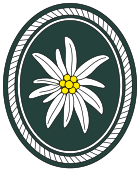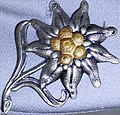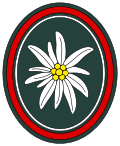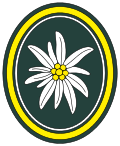1st Mountain Division (Bundeswehr)
|
1st Mountain Division |
|
|---|---|
 Association badge |
|
| active | Nov 14, 1956 to Sep 30. 2001 |
| Country |
|
| Armed forces | armed forces |
| Armed forces |
|
| Type | Mountain Division |
| last seat of the staff |
Garmisch-Partenkirchen Munich (as WBK VI / 1st Div) |
| march | Kaiserjäger march |
| commander | |
| last commander | Major General Kersten Lahl |
The 1st Mountain Division with staff in Garmisch-Partenkirchen (as a merged division and military area command in the Bayern barracks , Munich) was the 8th division of the German Army . The division was the only mountain division of the Bundeswehr , bundled the forces of the mountain troops and was therefore particularly suitable for fighting in difficult and especially mountainous terrain. In addition, as a large infantry unit with its own armored units, it was able to fight in open terrain. The 1st Mountain Division was stationed in southern Bavaria and was disbanded on September 30, 2001. Its successor as the only major mountain fighting association is today the 23 Mountain Infantry Brigade in Bad Reichenhall .
Identification marks and association badges

The soldiers wore the edelweiss as a sleeve and hat badge as a traditional symbol of the mountain troops, which initially only served the mountain troops of the Austro-Hungarian army as a branch of service from 1907 , but in October 1915 by the commanding general of the Austrian Southwest Front, Archduke Eugen von Österreich- Teschen , in the Hotel Elefant in Bressanone, was also awarded the German Alpine Corps as a badge in recognition of its performance in defending against the Italian offensives in the Austro-Hungarian Alpine region. In contrast to other divisions of the army, they carried an oval shield instead of a Gothic shield with the edelweiss as their association badge. In accordance with the heraldic tradition of the Army, the division's badge was surrounded by silver piping with black thread woven into it. The brigades carried the same badge with white, red or yellow piping, which also traditionally mark the first, second and third brigades of a division. The uniform of this division differs from the "normal" Bundeswehr uniforms in terms of the gray mountain cap and the service suit, which is cut differently from the mountain suit. The Gebirgsjägerbrigade 23 continues this tradition.
history
Army structure I
When German armed forces were re-established, a request by NATO originally provided for a mountain brigade to be set up in the Alps and a second in the Bavarian Forest . On July 19, 1956, the establishment of Mountain Brigade 104 began in Mittenwald , which was transferred to the 1st Mountain Division on December 1, 1956. The division was subordinate to the II Corps in Ulm . Initially, the division was subordinate to a staff and a staff company, the mountain combat group A 8, the mountain combat group B 8, the army aviation squadron 8, the mountain telecommunications company 8, the mountain tank reconnaissance company 8, the mountain hunter battalion 8, the mountain hunter battalion 18, the Mountain Jäger Battalion 28, the Mountain Jäger Battalion 38, the Mountain Artillery Regiment 8 (initially Mittenwald until around 1964, then Landsberg ), the Mountain Tank Hunter Battalion 8, the Mountain Pioneer Battalion 8 ( Brannenburg ), the Mountain Air Defense Battalion 8 ( Traunstein ), the Gebirgs-Sanitätsbataillon 8 (Kempten), the Gebirgs- Quartiermeisterkompanie 8, the Light Gebirgs-Feldzeugenstandsetzungcompanie 8, the Gebirgstragierkompanie 8 , the Gebirgs-Ersatzkompanie 8, and the Gebirgs- Feldjägerkompanie 8. In 1958 the division became part of NATO -Command structure integrated.
Army structure II - III
In Army Structure 2 (1959), the combat groups were renamed brigades from April 1, 1959 . In addition, a third brigade was reorganized. The Mountain Combat Group A 8 became the Mountain Combat Brigade 23 , and the Mountain Combat Group B 8 became the Mountain Combat Brigade 22 . The newly established brigade was Panzerbrigade 24 . Since 1960 the division has been commanded from Garmisch-Partenkirchen . In the same year, the supply battalion (building) 8 was set up in Mittenwald. In 1962 the mountain artillery battalion 225 followed in Füssen, in 1964 the establishment of the mountain air defense battalion 8 began in Traunstein and in 1965 that of the tank battalion 234 in Pocking . In 1966, Panzerbrigade 24 was renamed Panzergrenadierbrigade 24.
Army structure IV
In 1981 - as part of Army Structure 4 - the 24th Panzer Grenadier Brigade again became the 24th Panzer Brigade in Landshut and the 22nd Gebirgsjägerbrigade moved from Mittenwald as the 22nd Panzergrenadierbrigade to Murnau am Staffelsee . On March 19, 1981, the association was renamed “1. (8th) Mountain Division ”according to the uniform consecutive numbering of all divisions of the army was already canceled on November 23, 1982 at the instigation of the Bavarian Prime Minister Franz Josef Strauss . From 1981 the 1st Mountain Division was subordinate to the following units and units:
-
 Panzer Grenadier Brigade 22 (Murnau)
Panzer Grenadier Brigade 22 (Murnau) -
 Gebirgsjägerbrigade 23 (Bad Reichenhall)
Gebirgsjägerbrigade 23 (Bad Reichenhall) -
 Panzer Brigade 24 (Landshut)
Panzer Brigade 24 (Landshut) -
 Mountain Artillery Regiment 8 ( Landsberg )
Mountain Artillery Regiment 8 ( Landsberg )
-
 Mountain Air Defense Regiment 8 (Traunstein)
Mountain Air Defense Regiment 8 (Traunstein) -
 Mountain Tank Battalion 8 (Pocking)
Mountain Tank Battalion 8 (Pocking) -
 Mountain Armored Reconnaissance Battalion 8 ( Freyung )
Mountain Armored Reconnaissance Battalion 8 ( Freyung ) -
 Mountain Telecommunications Battalion 8 (Murnau)
Mountain Telecommunications Battalion 8 (Murnau) -
 Mountain Pioneer Battalion 8 (Brannenburg)
Mountain Pioneer Battalion 8 (Brannenburg) -
 Mountain repair battalion 8 ( Sonthofen , 2nd Mittenwald Company, 3rd and 5th Landsberg, 4th Munich (until 1988 as InstKp 760 of WBK VI))
Mountain repair battalion 8 ( Sonthofen , 2nd Mittenwald Company, 3rd and 5th Landsberg, 4th Munich (until 1988 as InstKp 760 of WBK VI)) - Mountain Restoration Battalion 83 (not active) (Regensburg)
-
 Mountain Supply Battalion 8 (Mittenwald) 1st and 2nd Mittenwald Company, 3rd Munich
Mountain Supply Battalion 8 (Mittenwald) 1st and 2nd Mittenwald Company, 3rd Munich -
 Mountain Medical Battalion 8 (Kempten)
Mountain Medical Battalion 8 (Kempten) - Mountain Field Replacement Battalion 81 (not active) (Mittenwald)
- Mountain Field Replacement Battalion 82 (not active) ( Bad Tölz )
- Mountain Field Replacement Battalion 83 (not active) (Kempten)
- Mountain Field Replacement Battalion 84 (not active) ( Bad Aibling )
- Mountain Field Replacement Battalion 85 (not active) (Landshut)
- Mountain Infantry Battalion 86 (not active) (Landsberg)
- Gebirgsjägerbataillon 87 (not active) ( Bruckmühl )
-
 Mountain Security Battalion 88 (not active) (Bad Tölz)
Mountain Security Battalion 88 (not active) (Bad Tölz) - Mountain Telecommunications Training Company 8 ( Maxhof )
-
 Mountain Army Aviation Squadron 8 (Penzing)
Mountain Army Aviation Squadron 8 (Penzing) -
 Mountain Music Corps 8 (Garmisch-Partenkirchen).
Mountain Music Corps 8 (Garmisch-Partenkirchen).
-
 Homeland Security Brigade 56 (Neuburg an der Donau), subordinated from January 1, 1985 until its dissolution in 1993
Homeland Security Brigade 56 (Neuburg an der Donau), subordinated from January 1, 1985 until its dissolution in 1993
-
Army structure V - dissolution
Panzergrenadierbrigade 22 in Army Structure 5 was disbanded in 1992. In 1994, the 24th Panzer Brigade was decommissioned. In 1994, the mountain division merged with Military District Command VI to form Military District Command VI / 1. Mountain Division. As a merged division and military area command, the staff was housed in the Bayern barracks , Munich. Subordinate were then the Mountain Infantry Brigade 23 in Bad Reichenhall , the Panzer Brigade 36 in Veitshöchheim and the newly established Pioneer Training Brigade 60 in Ingolstadt . The merger was reversed in 2001. Military District Command VI was retained, but the 1st Mountain Division was disbanded on September 30, 2001. The troops of the division were either disbanded or mostly subordinated to the 10th Panzer Division in Sigmaringen .
Whereabouts of the division troops
Mountain Artillery Regiment 8
The mountain rocket artillery battalion 82, stationed in Landsberg am Lech in the General-Feldmarschall-Ritter-von-Leeb barracks , was completely disbanded in 1993. The mountain observation battalion 83 also part of the artillery regiment 8. As mountain observation artillery battalion 83 was in 1993 as a mixed artillery Association (Landsberg / Lech, Lechrain barracks reorganized) in Artillerieregiment 4 with the reunification of the mountain artillery battalion 81 and mountain observation battalion 83rd Deactivated in 1996 and re-established as a partially active battalion as a partially active battalion as a mountain observation tank artillery battalion in Hemau from 1997, the move to Tauberbischofsheim took place in 2003 as an artillery reconnaissance battalion 83 (partially active) and was finally disbanded in 2007.
Mountain Reconnaissance Battalion 8
With the dissolution of the division in 2001, the battalion switched to the 10th Panzer Division. In 2007 it was renamed 8th Reconnaissance Battalion and subordinated to the 12th Panzer Brigade in Amberg , which was also part of the 10th Panzer Division . The successor to the Gebirgsjägerbrigade 23 was the Mountain Reconnaissance Battalion 230, which is stationed in Füssen and emerged from the GebPzArtBtl 225 there.
Mountain Telecommunications Battalion 8
The Mountain Telecommunication Battalion 8 took over the teaching assignment in 1994 from the dissolved Airborne Telecommunication Training Battalion 9 (Maxhof near Starnberg ) for the FmS / FSHElT in Feldafing . It was renamed to Mountain Staff and Telecommunications Training Battalion 8 and subordinated to the Command Support Regiment 60 in Munich (also subordinate to WBK VI / 1. GebDiv) . After the 1st Mountain Division was disbanded, it switched to Command Support Regiment 70 of Command Support Brigade 2 of the II. (GE / US) Corps in Ulm. Due to the dissolution of the II Corps, the change to Command Support Regiment 29 of the Armed Forces Base , which was disbanded in 2014, followed in 2006 and the associated renaming to Command Support Battalion 293 , which was then subordinated to the Command Support Command. The battalion has been stationed in Murnau am Staffelsee since 1966 .
Mountain Spy Battalion 8
In 1993 the battalion was subordinated to the 60th Engineer Training Brigade. After its dissolution, a change of position followed to the Mountain Infantry Brigade 23. The battalion moved to Ingolstadt .
Mountain Repair Battalion 8
In 1993 the battalion was moved to Füssen, the 3rd and 5th companies were in Mittenwald. In 1996 the Mountain Repair Battalion was restructured. The 1st and 2nd company were in the Füssen location, the 3rd company in the Feldkirchen location, and the 3rd / InstBtl 4 in Munich was renamed to the 4th / GebInstBtl 8 again. This company emerged from the InstKp 760, the independent InstKp of the WBK VI from the 80s. The InstAusbildungskompanie 7./GebInstBtl 8 in the Hemau location became 6./GebInstBtl 8. In 2003 it was subordinated to the Mountain Rifle Brigade 23 as Mountain Logistics Battalion 8. The locations are now Füssen and Mittenwald.
Mountain Restoration Battalion 83 (na)
The battalion was disbanded with the dissolution of the 1st GebDiv.
Mountain Supply Battalion 8
The battalion was disbanded in 1994.
Mountain Medical Battalion 8
The battalion was reclassified to Mountain Medical Regiment 42 in July 2003 .
Field replacement battalions 81–85, Gebirgsjäger battalions 86 and 87, Gebirgssicherungsbataillon 88
The battalions were disbanded in 1992/1993.
Mountain Field Hunter Company 8
The company was set up in Mittenwald in 1957. One platoon / military police command was relocated to Füssen in 1958 and to Bad Reichenhall in 1959. In 1972 the company was partially cadre and consisted only of one service command in Mittenwald.
Mountain Telecommunications Training Company 8
In 2004 the company was disbanded.
Mountain Army Aviation Squadron 8
It was dissolved in 1994.
Mountain Music Corps 8
The music corps was subordinated to the Military District Command IV .
Assignments abroad
From 1993 units of the division were deployed in Somalia , Macedonia , Albania , Kosovo and Bosnia .
Commanders
| No. | Surname | Beginning of the appointment | End of appointment |
|---|---|---|---|
| 15th | Major General Kersten Lahl | 2000 | September 30, 2001 |
| 14th | Major General Dieter Henninger | April 1, 1998 | 2000 |
| 13 | Major General Rainer Jung | April 1, 1995 | March 31, 1998 |
| 12 | Major General Franz Werner | April 1, 1990 | March 31, 1995 |
| 11 | Major General Jürgen Schlueter | April 1, 1986 | March 31, 1990 |
| 10 | Major General Horst Netzler | April 1, 1983 | March 31, 1986 |
| 9 | Major General Eberhard Hackensellner | October 1, 1980 | March 31, 1983 |
| 8th | Major General Michael Greipl | 1st October 1975 | September 30, 1980 |
| 7th | Major General Ernst Metz | January 1, 1972 | September 30, 1975 |
| 6th | Major General Rainer Schwartz | April 1, 1971 | December 31, 1971 |
| 5 | Major General Joachim Horbach | October 1, 1967 | March 31, 1971 |
| 4th | Major General Karl Wilhelm Thilo | April 16, 1965 | September 30, 1967 |
| 3 | Major General Karl-Heinz Wirsing | October 1, 1962 | April 15, 1965 |
| 2 | Major General Georg Gartmayr | October 1, 1959 | September 30, 1962 |
| 1 | Brigadier General Hans Buchner | November 14, 1956 | September 30, 1959 |
Web links
- Literature on the 1st mountain division in the catalog of the German National Library
- Stock BH 8-8 "1. Mountain Division ”in the Federal Archives
Coordinates: 48 ° 12 ′ 0 ″ N , 11 ° 35 ′ 41 ″ E



